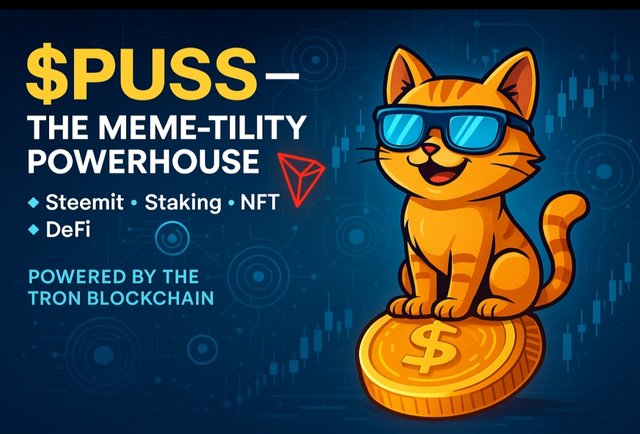DEPIN and SPUSS COIN Integrations, What You Should Know
INTRODUCTION
As blockchain technology stretches beyond virtual world into real-world geographies, decentralized infrastructure takes on a more serious note. DePIN exemplifies this evolution—where real-world networks are owned and operated by the communities. Situated right at the center of this emerging space, PUSS COIN is uniquely poised to act as a financial and governance tool in the sustenance of such decentralized systems.
DePIN systems are incentivized for community members to offer resources such as hardware, bandwidth, or electricity. Thus, PUSS COIN becomes an obvious choice to be deployed as a unit of exchange and reward with these incentive systems in place; it offers the advantages of instant payments, microtransactions, and staking rewards, paving the way for a fair infrastructure rollout by the community, away from centralized control.
PUSS COIN can also automate governance processes for DePIN projects through the means of token-powered smart contract enforcement of service-level agreements, reward distributions, and penalty enforcement for nonperformance, thereby enhancing transparent trust and reducing the cost of administration. Thus, PUSS COIN is much more than a digital currency-the token acts as the lifeblood and fuel for sustainable, decentralized infrastructure systems in multiple industries.
CROWDFUNDING DEPIN PROJECTS
Crowdfunding plays a major role in promoting the growth of decentralized infrastructure. PUSS COIN could be used to fund DePIN community projects in sensor networks, meshed connectivity, or even satellite ground stations. By lowering the barrier to entry, PUSS COIN enables the average folks to back physical infrastructure projects.
On the other side of the coin, it can act as a native currency for decentralized fundraises, replacing fiat money and centralized intermediaries. Contributors are then kept abreast of developments; depending on the scheme, they may be rewarded or may even acquire a degree of ownership over the infrastructure. This model thus creates shared incentives among stakeholders to push for the long-term success of the deployed infrastructure.
PUSS COIN closes the gap between vision and implementation by giving communities the ability to initiate and fund local DePIN networks. Be it for agricultural sensors in rural regions or wireless coverage in remote small towns, crowdfunding with PUSS COIN ensures the infrastructure addresses the real needs of the people and not corporate agenda.
SMART CONTRACT-POWERED AUTOMATION FOR IOT
Decentralized payments and access control represent an excellent waypoint for further improvements of IoT. Using smart contracts with PUSS COIN, devices can trigger payments automatically when a service for the device is used. In one example, drones charge clients for flights; in another, charging stations receive tokens for the delivery of power.
Basically, automation abolishes the requirement for any human intermediate or billing centres. It builds trust and edge speed together. Weather sensors or smart locks may work in an IoT environment while compensating the owners with PUSS COIN based on their usage time or on uptime and bandwidth delivery metrics in another mode system.
This integration would pave the way for more efficient autonomous machine-to-machine economies. PUSS COIN smart contracts dissolve bottlenecks found in traditional systems while promoting peer-to-peer service models. As devices become more capable, this programmable token economy will promote more trust-less interactions, thereby rendering commercialization and technical scalability of decentralized IoT feasible.
INCENTIVIZING DEVICE UPTIME
A network of utmost performance is the requirement for any DePIN network. With PUSS COIN, such devices can be rewarded directly for being online and providing legitimate data most of the time. This motive is strong enough to encourage node operators to maintain uptime, consequently ensuring greater stability of the infrastructure, especially for systems that require uninterrupted data flow.
Uptime-based incentives also discourage malicious or low-quality participation. Instead of fixed payments, node operators are rewarded on such bases as uptime, reliability, and accuracy. PUSS COIN may be distributed in a trustless and automatic manner according to smart contracts and verifiable uptime logs maintained on-chain.
Compensation being dependent on performance encourages continued participation and promotes higher data integrity. PUSS COIN thus becomes a means to define quality and ensures the best nodes that can truly perform attain payout consistently-supporting the growth of a healthy DePIN ecosystem.
DECENTRALIZED TELECOM PAYMENTS
Telecommunication services can be provided by way of decentralized physical networks offering mobile data and Wi-Fi. Access to services can be paid through PUSS COIN, thus presenting a decentralized telecom concept. Users can access hotspots or bandwidth providers and pay in PUSS COIN, without any telecom providers.
Using smart contracts, payments are made for minutes used, data consumed, and signal strength provided. This completely lifts billing disputes and gives users greater control over their spending. It also allows telecom services to enter underserved areas where traditional ISPs are refusing to spend due to low-profit margin.
With PUSS COIN, communities can form a decentralized mesh network, cheap and accessible. Local businesses would earn tokens for running nodes, while users enjoy cheap peer-powered connectivity. Telecom access is now something that different groups work together on, instead of just coming from the top down.
CONCLUSION
Integrating PUSS COIN into a DePIN brings a large range of possibilities for decentralized infrastructure development. It enables the scaling, efficiency, and community-driven operation of crowdfunding, reward for performances, automated transactions with IoT, and decentralized telecom access. This reduced dependence on central authority so proceeds towards a more welcoming and distributed future.



https://x.com/Memephiz148421/status/1926139699950690393
Upvoted! Thank you for supporting witness @jswit.
https://x.com/Memephiz148421/status/1919432393728901390
https://x.com/Memephiz148421/status/1919430052954923220
https://x.com/Memephiz148421/status/1919429726784930298
https://x.com/Memephiz148421/status/1919429211942453534